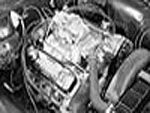
The poor car. With its Hurst-shifted Muncie four-speed, buckets and console and factory tach and gauges, it looked every part of a ’65 GTO minus the telltale “6.5 Liter” badges on the fenders. Its fenders, instead, bore odd “PMD 6” emblems, which gave away the sickly, smoking 215ci inline-six underhood, a mill better suited to hauling hay than hauling tail.
From the start, we intended to change that. No, we never planned on cloning a GTO; we wanted something far more capable than a stock 389. As luck would have it, we’d already built a 501hp Poncho 455, which had been languishing at our dyno shop since appearing in the Jan. ’01 issue. That fit the bill perfectly.
What we thought would be a basic bolt-in deal turned into several months of parts searching and modifying. Using modern speed parts often requires accommodating or modifying other components. But we wanted to do things right, which always takes way longer than slapping the whole mess together. And we think you’d agree that installing a $6,000 engine in a car you love is worth the extra time spent.
The beautiful thing about Pontiac V-8s is their common external packaging—so don’t call this 455 a “big-block.” That meant we were able to use many stock ’65 GTO pieces from Year One, as most of these parts can’t distinguish this motor from a 389. A huge benefit of working with Year One is having a one-stop shop at your fingertips. Being able to order everything from a complete cooling system to clutch linkage from a single catalog saves an incredible amount of time. We opted to install a McLeod clutch and flywheel, a Milodon oil pan, Doug’s headers, Flowmaster exhaust, an MSD ignition, and a set of Auto Meter gauges to complement the torque-monster motor.
Was all the extra installation time worth it? When a new motor roars to life on the first blip of the ignition, runs smoothly, doesn’t leak, drives effortlessly, and sounds killer, we think it’s time well spent. With almost 600 lb-ft of torque on tap, though, driver input to the worn-out stock suspension is more of a suggestion than a certainty. In the meantime, we’ll get by smoking the tires from a 50 mph roll.